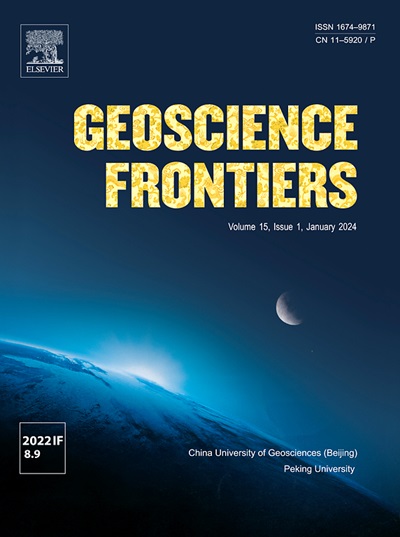Change in the direction of Early Cretaceous tectonic extension in eastern North China Craton as the result of Paleo-Pacific/Eurasian plate interaction
IF 8.9
1区 地球科学
Q1 GEOSCIENCES, MULTIDISCIPLINARY
引用次数: 0
Abstract
How the subduction direction of the Paleo-Pacific plate beneath the Eurasian plate changes in the Early Cretaceous remains highly controversial due to the disappearance of the subducted oceanic plate. Intraplate deformation structures in the east Asian continent, however, provide excellent opportunities for reconstructing paleostress fields in continental interior in relation to the Paleo-Pacific/Eurasian plate interaction. Anisotropy of magnetic susceptibility (AMS), geological, and geochronological analyses of post-kinematic mafic dykes intruding the detachment fault zone of the Wulian metamorphic core complex (WL MCC) in Jiaodong Peninsula exemplify emplacement of mantle-sourced dykes in a WNW–ESE (301°–121°) oriented tectonic extensional setting at ca. 120 Ma. In combination with the results from our previous kinematic analysis of the MCC, a ca. 21° clockwise change in the direction of intraplate extension is obtained for early (135–122 Ma) extensional exhumation of the MCC to late (122–108 Ma) emplacement of the dykes. Such a change is suggested to be related to the variation in subduction direction of the Paleo-Pacific plate beneath the Eurasian plate, from westward (pre-122 Ma) to west-northwestward (post-122 Ma).

古太平洋-欧亚板块相互作用下华北克拉通东部早白垩世构造伸展方向的变化
早白垩世,由于大洋板块的消失,古太平洋板块在欧亚板块下的俯冲方向发生了怎样的变化,至今仍有很大的争议。然而,东亚大陆的板内变形构造为重建与古太平洋/欧亚板块相互作用有关的大陆内部古应力场提供了极好的机会。胶东半岛五联变质核杂岩拆离断裂带运动后基性岩脉的磁化率各向异性、地质和年代学分析表明,在约120 Ma的构造伸展背景下,幔源岩脉在WNW-ESE(301°-121°)方向侵位。结合我们之前对MCC的运动学分析结果,从早期(135-122 Ma) MCC的伸展发掘到晚期(122-108 Ma)堤防的侵位,获得了板内伸展方向顺时针方向约21°的变化。这种变化可能与古太平洋板块在欧亚板块下俯冲方向的变化有关,即从西向(122 Ma前)到西向西北方向(122 Ma后)。
本文章由计算机程序翻译,如有差异,请以英文原文为准。
求助全文
约1分钟内获得全文
求助全文
来源期刊

Geoscience frontiers
Earth and Planetary Sciences-General Earth and Planetary Sciences
CiteScore
17.80
自引率
3.40%
发文量
147
审稿时长
35 days
期刊介绍:
Geoscience Frontiers (GSF) is the Journal of China University of Geosciences (Beijing) and Peking University. It publishes peer-reviewed research articles and reviews in interdisciplinary fields of Earth and Planetary Sciences. GSF covers various research areas including petrology and geochemistry, lithospheric architecture and mantle dynamics, global tectonics, economic geology and fuel exploration, geophysics, stratigraphy and paleontology, environmental and engineering geology, astrogeology, and the nexus of resources-energy-emissions-climate under Sustainable Development Goals. The journal aims to bridge innovative, provocative, and challenging concepts and models in these fields, providing insights on correlations and evolution.
 求助内容:
求助内容: 应助结果提醒方式:
应助结果提醒方式:


